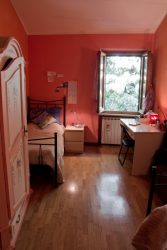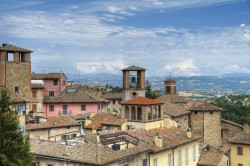 Are you planning to study abroad in Perugia, Italy this fall? We at the Umbra Institute have constructed a list of 6 things you shouldn’t forget to pack for your fall abroad in Perugia.
This list is not everything you need, but rather a selection of some of the most common items that our students forget each fall:
Are you planning to study abroad in Perugia, Italy this fall? We at the Umbra Institute have constructed a list of 6 things you shouldn’t forget to pack for your fall abroad in Perugia.
This list is not everything you need, but rather a selection of some of the most common items that our students forget each fall:
- A winter coat
Italians often spend September soaking up the sun on the beach and tourism easily paints Italy as the ideal location for sun-bathing warmth. However, November and December in Perugia can get chillingly cold. It won’t snow, but snow can be seen on the distant mountain tops as the wind carries a cold breeze into the city. Winter coats can be quite expensive in Italy so we advise that students bring one from home.
- Ciabatte or pantofole
That’s right, Italians wear shoes in their homes. This is primarily because most Italian apartments do not have carpeted floors. In warmer months, ciabatte (which are like flip-flops or… crocks!) are worn to keep your feet clean and comfortable. In colder months, pantofole (winter slippers) are worn to keep feet warm as they step along cold wood or tile floors.
- Warm clothes to wear at home
Italian homes and public buildings are often cooler than what the average American is used to in the winter. This is because energy is much more expensive in Europe than it is in the U.S., so Italians don’t keep their heat blasting all day, every day. Instead, in part due to Italian law, Italians turn the heat on for a limited number of hours each day, and walk around wearing sweaters and warm pants. Italian law even dictates the range of dates during the year when heat can be used (a period that typically doesn’t start before early- or mid-November).
- Rain boots
Winter in Italy doesn’t mean snow, it means rain. Students will find that their main method of transportation in Perugia and throughout Italy and the rest of Europe will be with the use of their own two feet. Rain boots can help keep students warm and dry (while Umbrellas can be purchased at the Institute or throughout Perugia).
- Comfortable walking shoes
There are three characteristics of walking in Perugia: uneven cobblestones, stairs, and hills. Perugia is a beautiful hill-top city with postcard-like panoramic views around nearly every corner. However, while abroad, students find that walking is their most comfortable and commonly used way of getting around town (or Europe). Comfortable walking shoes are not flip-flops, and sometimes not even sandals. Students often find that the most comfortable shoes are shoes designed for running or walking.
Note for those of you who may enjoy high-heels: Be careful wearing heels in Italy! It is easy for a stiletto to get caught in a cobblestone crack, and though Umbra staff is available to help you seek medical assistance, no one wants to see you fall or twist your ankle on your way to enjoy a nice evening walk. Our students usually avoid heals during the semester, especially after their first night out; and many ask us to warn others about how uncomfortable such shoes can be.

- Cold and flu medication*
Perugia is beautiful year-round, though it is important to know that winter can bring rain and cold wind. Not all students get ill as the seasons change, but for those of you who choose not to bring items 1 through 4, we suggest bringing something to treat a cold or the flu. Italian winters can get cold, and the altitude makes a difference. Choosing not to bundle up or dress appropriately for winter rains, can cause illness. Italian pharmacy instructions will be given to all students in the Guide to Perugia, provided during orientation weekend. Umbra staff is available to make arrangements with a doctor.
*be sure to follow all travel guidance for transporting medication overseas. Consult your pre-departure documents, travel.state.gov, or the CDC (special note about prescription medicines)



 Are you planning to study abroad in Perugia, Italy this fall? We at the Umbra Institute have constructed a list of 6 things you shouldn’t forget to pack for your fall abroad in Perugia.
This list is not everything you need, but rather a selection of some of the most common items that our students forget each fall:
Are you planning to study abroad in Perugia, Italy this fall? We at the Umbra Institute have constructed a list of 6 things you shouldn’t forget to pack for your fall abroad in Perugia.
This list is not everything you need, but rather a selection of some of the most common items that our students forget each fall: